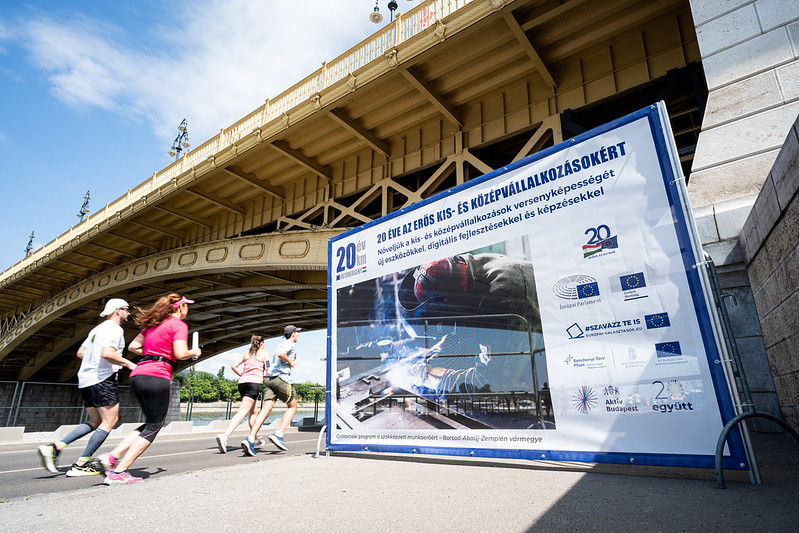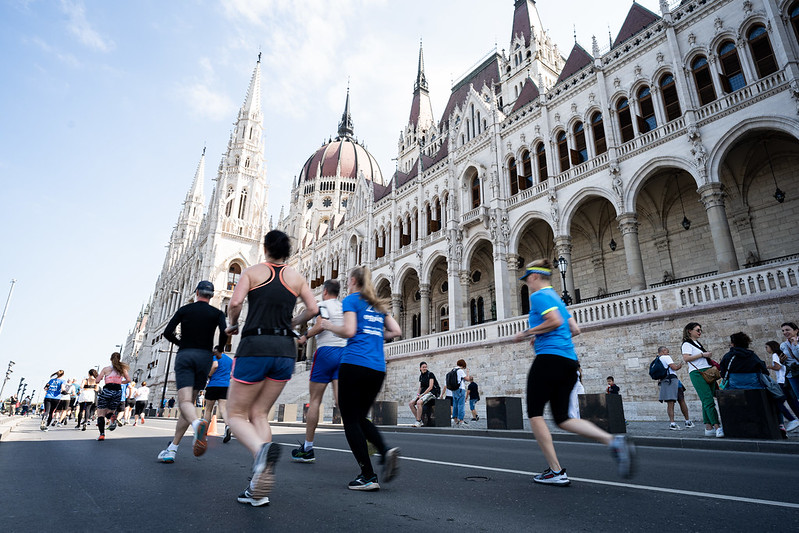Hungary celebrates 20 years of EU membership
- 05 Jun 2024

The Commission Representation and the European Parliament Liaison Office in Budapest has always organised ‘Europe Day’ on a grand scale in Budapest. The idea to pair the event with a running race came up exactly a decade ago. Ten years of membership, 10 kilometres to run. Already at the time, it had been recognised, that Cohesion Policy had a major impact on peoples’ lives, so why not show-case this along the route of the race? Since then, the number of kilometres to run increased every year, together with the EU-funded projects along the way.
Over the past two decades, cohesion policy has brought major benefits to the country, from green energy to efficient transport. Almost € 50 billion were invested to make Hungarian regions more competitive, resilient, and sustainable. What better occasion to showcase these achievements than the 20th anniversary of EU membership?
Projects were selected around areas that have shaped EU policy making in the last two decades. ‘20 years fighting the impacts of climate change’, ‘20 years for local communities’, ‘20 years for science and innovation’, were but a few of the objectives that guided the project selection. These examples showcased Cohesion Policy investments that not only made a difference on the local, but on the European level as well.
Energy, Innovation
One of the main areas in which Hungary has received funding is energy. Located in Szeged, Europe’s largest urban geothermal network will heat 27 000 households and more than 400 public buildings, reducing annual greenhouse gas emissions by 434 000 tonnes. This investment was a flagship project of the European Commission highlighting the possibilities to replicate in other European Member States.
To continue with a European-scale innovative investment, the ELI-ALPS research centre shows that by supporting research and innovation, the European Union encourages collaboration between research teams from different countries and disciplines.
The ELI-ALPS laser research centre in Szeged is one of the largest scientific investments in Europe, enshrining the EU’s commitment towards research as well as the hope to see it bear the fruit of major scientific breakthroughs. which could underpin the global discoveries of the future in many fields of science. Thanks to the project, Szeged figures more prominently than ever on the map of Europe as one of the regional centres of international science.
Skills training and job creation
To ensure that people have the necessary qualifications for the digital economy, vocational training at nine centres across the country has been overhauled. Students learn skills with the help of digital tools that simulate production processes.
Efforts to reduce the number of school dropouts and tackle inequality in education has entailed provision improvements to pedagogical services., like the support for at-risk pupils Over 160 000 pupils in 457 institutions benefited from this scheme.
One way of bolstering SME competitiveness and preventing exclusion is to enable young people who are not in education, training or employment to find work. Companies have been encouraged to offer traineeships through which young people can gain skills and experience. One programme helped over 136 000 people to enter the job market.
Jobseekers with business development plans between 18 and 30 years old received grants and nearly8 500 enterprises have been created as a result.

Conservation and climate change adaptation
Energy programmes have supported several investments to mitigate climate change. In the Körös-Maros National Park, winter shelters have been built for Hungarian Grey cattle. Conditions in the park are now suitable for grazing, which is essential for the maintenance of grassland. Under the same project, steps were taken to conserve great bustard habitats and saline steppes and marshlands around Dévaványa.
Adaptations to climate change include the replacement of the heating system in the sports halls of the Dr László Szepesi Agricultural Vocational School. This has reduced the school’s heating costs and energy consumption.
Thanks to the newly built disaster management centre in Kecskemét, some 212.000 residents are now provided protection.
Social inclusion
Education and social inclusion have been two other major areas of focus. Cohesion policy has helped creating some 60 000 nursery places across Hungary and supported 99 cities in designing over 6 000 local projects.
In Váralja, a deprived neighbourhood in Siklós, living conditions were improved. Housing was modernised, green spaces revitalised, and roads repaired. In addition, drainage networks were extended, and surveillance cameras installed to improve safety.
One of the most deprived places in Hungary, Kunhegyes, benefited from EU support to improve residents’ quality of life. A community centre was created, along with a mentoring system, leisure opportunities and mental health programmes. Parents with young children now receive visits from health workers. The benefits of this investment have included a reduction in school dropouts.
The Sure Start Children’s House programme at Babócsa has improved the social inclusion of disadvantaged families with young children. It prepares children for nursery school and provides practical guidance to parents, which are part of efforts to create a harmonious community.
Across Hungary, more than 4 000 homeless people receive healthy meals every day, as well as counselling to address mental health and addiction problems. People’s physical health also benefited from EU-fnded social inclusion initiatives. A regulatory framework for screening tests was developed, and cancer screening was improved. In addition, almost 1.5 million people have participated in health promotion programmes and healthcare professionals have received free training.
Digital and transport infrastructure
Cohesion policy has supported the development of infrastructure to make public administration more efficient. Improvements to broadband networks have allowed more people to take advantage of e-administration services. More than 180 water, electricity, gas, heating and telecommunications companies use these services, making administrative procedures for customers easier.
Extensive cohesion funding has boosted the country’s transport infrastructure. An important project was the reconstruction of Budapest’s M3 metro line, which carries over 500 000 passengers daily. A smaller but no less valuable initiative was the construction of a 12 km cycle path between Oroszlány and Tatabánya. Offering commuting and leisure opportunities, more than 600 people a day use the path, reducing road congestion and transport emissions. This latter is just one example of many, providing sustainable transport opportunities for locals across the country.
What next?
The European Commission, both from its headquarters in Brussels and its representation in Budapest, aimed to show how these local investments contribute to people’s lives and that as European citizens, Hungarians are part of the change that shape Europe’s common future through Cohesion Policy investments.
Across this Hungary, keep your eyes open as this “exhibition” will be on tour during Summer 2024
Happy 20th Hungary!


